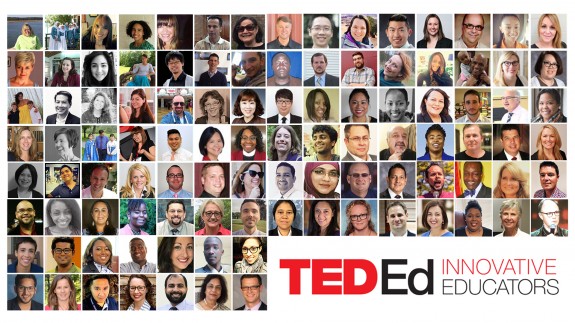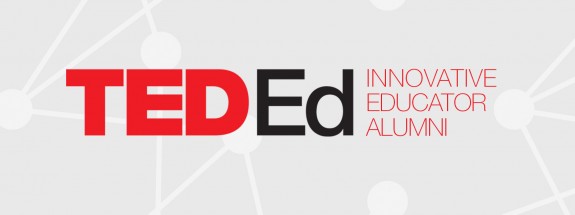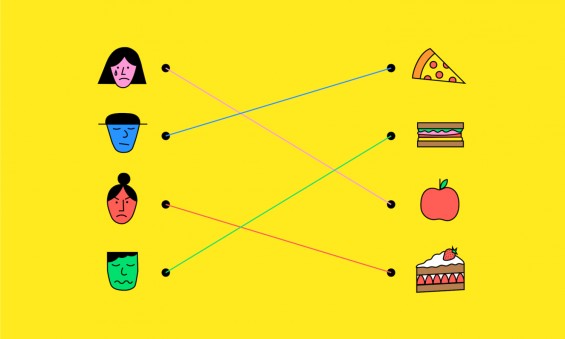
Introducing the launch of the TED-Ed Innovative Educator Alumni Innovation Projects
In 2015, TED-Ed launched the TED-Ed Innovative Educator (TIE) program, a year-long professional development program for dynamic educators who are dedicated to celebrating the ideas of students and teachers around the world. Six years later, we have 104 alumni representing over 20+ countries, constantly thinking of new ways to innovate in education.
2020 brought on unpredictable levels of global change: a pandemic, racial reckoning, and world-wide political upheavals. The traditional system of schooling has experienced significant disruptions in the past year.
These changes signaled a call to action: the TIEs, coming from rural, urban and suburban communities, in roles including classroom teachers, adjunct professors, superintendents, librarians, college advisors, district tech specialists, and more, are coming together to build some solutions.
First, the TIEs identified problems in global education and turned them into four main Opportunity Statements:
1. Redesign instruction: Reimagine how instruction can comprehensively meet the needs of all students.
2. Redesign how we address inequities: Reimagine how to empower teachers and communities to address race, equity, inclusion, and justice issues.
3. Assess innovations in pandemic: Assess how to carry forward the innovations created during the pandemic into full-time in-school instruction (and continue to build a culture of school/district innovation).
4. Reinvest in educators’ well-being: Reinvest in how best to support our teachers and admin, professionally and personally.
Next, each TIE has chosen one Opportunity Statement to work on for their Innovation Project. Follow their journey over this year as they collaborate, design, test, and share their innovations; we will be reporting back through the project development.
Explore why some TIEs are working on their chosen Innovation Project:
Redesign instruction
Alejandra Guzman (Texas, USA)
I have worked in the curriculum and instruction department in two different school districts over the last 6 years. I know that in many schools, some parts of instruction, curriculum, and assessment are out-dated, focused too much on standardized assessments and not on deep learning, making connections with other content areas, and application to solve real-world problems. This type of instruction will strengthen student critical thinking, problem solving, and communication skills. I believe rethinking what instruction should and can look like and creating a realistic instructional model will help many educators go back to focus on what the true meaning of education should be.
Christie Simpson (Perth Western, Australia)
I work at school in a low socio-economic area. We have high rates of poverty and transiency and over 60% of our students have some developmental trauma. Only 35% of our Year 7 students arrive at high school able to read at grade level. 35% are still learning to read with fluency and 30% are still learning to decode words. How do teachers cater for this? Mostly, they try to muddle through the vast amounts of content in our curriculum, often using ineffective – though well-intentioned – discovery or inquiry based learning practices. I know there is great value in those models, but I also know that our students need strong foundational literacy and numeracy capacity as well as concrete background knowledge which they can draw on as they start to inquire. I’d like to see us arm teachers at both ends of the instructional spectrum, so that they can competently and effectively meet their students at their point of need.
Georgios Villias (Athens, Greece)
I honestly believe that living in a world which overwhelms us daily with information, it is humanly impossible to stay focused on something unless it is useful, exciting, and meaningful for you. This reality applies to schools as well. Instruction should be much more than just content knowledge. Instruction should also care about developing skills, showcasing each individual’s unique talents, engaging learners to act in real-life situations, nourishing and inspiring youngsters’ minds, teaching moral values in a social context and so much more. Molding students’ character, encouraging active citizenship, and raising the next generation of ethical problem-solvers always start from family and school. I would be honored as an educator to make even a minor, constructive contribution to my students’ lives towards that direction.
“Instruction should be much more than just content knowledge.”
Kristin Leong (Washington, USA)
Students and teachers deserve more diverse, timely, and dynamic resources and more support. Teaching is hard. Online teaching during a pandemic, a civil rights uprising, and an insurrection is really hard. In addition, the news cycle is relentless. The Sisyphean task of educators to constantly find great resources to build an engaging curriculum that responds to quickly-shifting current events is profoundly challenging. Lastly, our students are increasingly diverse in race, culture, sexual orientation, and gender identity, while our teachers remain mostly white, female, and heterosexual. Connecting with young people across these divides, when you instruct 30+ students at a time, only compounds the challenge of designing original curriculum. As a former QPOC teacher myself, I know teachers need more support and a reliable flow of trustworthy and updated resources by diverse sources to connect their classrooms to current events in ways that inspire students to engage with the world and their learning.
My weekly newsletter ROCK PAPER RADIO is one way I’m offering support to teachers. Every Thursday, I share three multimedia stories by diverse thinkers and creatives delivered via email for free. The newsletter is quick (less than five min to read), and organized by format (an audio feature, an essay or article, a human interest story). All stories are linked to current events and framed for personal engagement.
The Black Lives Matter movement has shaken awake all of the systems that make up society, including our education system. Young people are paying attention and rightfully demanding more inclusive and more current curriculum now. I’m thrilled to be part of this TIE alumni group working to usher in that much-needed change with heart, innovation, and more than a little bit of courage.
Mahrukh Bashir (Tangerang Selatan, Indonesia)
I have encountered instructional models dominated by the ideas of transfer of content and knowledge with the implicit understanding that learners are merely vessels to be filled. This system had, and still has, standardized curricula delivered in standardized ways and the effectiveness assessed using standardized testing. On the other hand, I have been refreshingly greeted by ideas of developing students’ talents and dispositions, differentiation and individual needs. However, the perfect instructional model that takes into account individual needs and delivers academic rigor and deep learning is yet to present itself. I want to explore and implement an innovative model of instruction that comes closest to this, what has effectively become “the holy grail of modern education.”
Reimagine how we address inequities
Craig Zimmer (Ontario, Canada)
I love the fact that we are having some real conversations here. We need to advocate for students and show that, as educators, we are on their side no matter what. In 2021, we have to ensure that education is inclusive and accessible to all students. This is going to require very big changes and it all starts when we go to work to bring about real reform.
Fred Sagwe (Kisii, Kenya)
I believe the approach to inequities on race, equity, inclusion and social justice issues means different things depending on the region and countries. For example in Kenya and most parts of sub-Saharan Africa, the challenges have a gender-based perspective. There was the challenge of FGM among young girls who, after circumcision, are married young, hence dropping out of schools. Also, marginalization in less developed regions in Kenya also hinder favorable educational outcomes. School infrastructure is a concern too, including the availability of reliable internet connectivity. The government is trying to remedy the situations.
Jen Ward (Michigan, USA)
This past year has served to highlight in so many different ways the divides, gaps, and inequalities that are systematized in our educational spaces. I selected this project because I believe as a global group of change-makers, we are able to come together, dig deep, and put forth proposals for real change to ensure that all students have an opportunity to learn, grow, and be heard.
Sandy Chambers (North Carolina, USA)
Working to change a system that perpetuates inequities is my calling. Working with others who believe that change can happen is inspirational and hopeful. As an administrator, I have more “power” than I think. I know we can make a change!
“Empowering starts with radical truth-telling, which means listening to all stakeholders, especially students.”
Shameka Williams (Georgia, USA)
I want better for all students that have unfair disadvantages due to a system that was not historically designed with all children in mind. I want better for each generation, so they do not experience the same setbacks as those before them and have to work harder to prove themselves as equal. Moreover, I want to tackle this problem with others that bring different perspectives so that the narrative and outcomes are inclusive of everyone! One perspective cannot be the solution to this global issue.
Tim Leistikow (Minnesota, USA)
I am not sure how we achieve any meaningful change in our system (I teach in the USA, but I assume similar issues in other countries) until we start telling the truth about the history that led to the inequities that exist and persist today. Empowering starts with radical truth-telling, which means listening to all stakeholders, especially students. I have done a project with students on creating the ideal education system for the past 10 years, and every cohort sees addressing inequities around race, gender, religion, sexuality, socio-economic status, and more, as being a primary first step to making schools a better place for students.
Wiputra Cendana (Tangerang, Banten, Indonesia)
Equity and equality become great challenges especially for the students who have learning difficulties, connectivity issues, and other variables. This project is to give a new learning model as I synthesize from a particular current teaching experience. I truly hope the project will be a small sparkle and idea which can equip educators around the world to confront these issues. Entrust the learning essence and ‘meat’ will be absorbed well by the students across the world. Let’s think globally, connect intentionally, share clearly, and act locally.
Assess innovations during the pandemic
Lisa Winer (Florida, USA)
I found that during Hybrid teaching, I couldn’t see my students’ work – they used to work on whiteboards or I could walk around and see how well they understood. But even then, I didn’t hear from or see everyone. For my capstone project for my EdD, I am researching how to add ed tech to the classroom to help capture student thought and to include the voices of the students who are quiet or who aren’t risk-takers. I want to hear from all students and showcase them all as well. This was something brought forth from the pandemic because never before had I not been able to see the work of my students as they were thinking.
Maggie Muuk (Kching, Malaysia)
I would want to know more about innovation as many of my students were left behind by this pandemic. Many of them do not have sufficient access to gadgets or internet to enable them to stay aligned with the lesson. Currently, we are only using WhatsApp to communicate. I’m looking for low technology to make them want to study.
Małgorzata Guzicka (Legnica, Poland)
I truly believe that because of the pandemic, we have rediscovered online learning. Teachers are learning how to use different platforms and educational apps to enhance online learning; students are doing projects in groups using educational websites. I think it would be awesome if students and teachers from different countries could work and learn from one another, do projects together and meet online. I am thinking about a project that could help teachers and students learn from one another about their cultures.
Shawn T. Loescher (California, USA)
The pandemic has represented a time of tremendous learning for our educational and social institutions. Within the pandemic, nearly 1.5 billion children around the world have had disruptions to their typical educational environment. Through this disruption, we have learned that there are multiple modalities and ways of learning. To me, the challenge we face as we emerge from the pandemic is which of the many successful lessons we’ve learned should be adopted and institutionalized to advance academic performance, address inequities, and redesign our schools, in order to create a more human-centered experience that is sustainable in scale and scope.
“The students we will meet on the other side of this pandemic will deserve better than a return to the ‘old normal.’”
Susan Herder (Minnesota, USA)
Educators and students were forced to change suddenly in the midst of the pandemic, often without adequate support. I chose this project because as we return to a combination of in-person and online classes, teachers need to be able to let go of the practices that are not effective and continue to use innovations that engage students and close gaps and eliminate inequities.
Tim Couillard (Virginia, USA)
Well frankly, there is no going back. The students we will meet on the other side of this pandemic will deserve better than a return to the “old normal.” I suspect (and secretly hope) they will demand it. Amid the toll and tragedy of this past year, I hope we find a way to get education “unstuck,” to shed the lockstep factory model of learning once and for all. Let’s hope that necessity is still the mother of invention. I suspect that we have all had a chance to cultivate some new habits of mind that will be as useful in-person as they are at a distance. I’m excited to see where that leads us.
Lastly, I hope that we abandon, or at least push back against, the anxiety-fueled march of “more is more” when it comes to education. Students are people first, learners second. They are more than the test data the system can coax from them to tout their “success.” If we truly believe in social and emotional learning, we need to reject it as a mere tool to boost productivity. We need to not only mean what we say, but ask ourselves if our actions match our words. Ultimately, I hope we can look back on all this and say, tired as we are, we still found the strength to work for a world where what we have gained from this pandemic will be greater than all we have lost.
Umar Anjum (Lahore, Pakistan)
I am working on this as I have seen that inequalities and gaps in the education system have been growing and merely adding more resources is not helping. That is why I believe the answer is hidden in the Innovations.
Reinvest in educators’ well-being
Sarah Harkin (Shanghai, China)
Self-care isn’t just a buzzword; it’s critical. So much is asked of teachers. I hope to find real ways to help build teacher capacity and systemic support within schools in order to better prioritize teacher well-being, specifically mental health and work-life balance.
“Self-care isn’t just a buzzword; it’s critical.”
Sharon Hadar (Raanana, Israel)
During the pandemic, most things have become accelerated – emotions, thoughts, worries, health issues, financial difficulties, and more. On top of this, education systems and educators have been put under the microscope. We get so much criticism from parents, the media, politicians, our administrators, and more.
We, the educators, are the foundation and base for our communities. Our well-being is essential for our communities; teachers have to support each other, be strong, and stay united. It is also making sure there is a way to release and vent, while at the same time find the strength to continue doing our job the best way we can. I want to find the right way to do this, together with the rest of the TIEs, as a part of a strong and cohesive group that can change people’s viewpoint about teachers. It’s time for us to take care and support each other. I am sure that with this project we will find the best way to achieve this!





